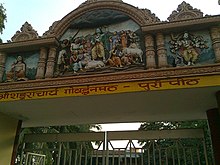 Govardhan Math logo Govardhan Math logo | |
 Govardhan Math Entrance Gate Govardhan Math Entrance Gate | |
| Founder | Adi Shankara |
|---|---|
| Type | Religious |
| Location |
|
| First Shankaracharya | Padmapadacharya |
| Present Shankaracharya | Swami Nischalananda Saraswati |
| Website | govardhanpeeth.org |
Purvamnaya Sri Govardhana Pitham or Govardhan Math (ଗୋବର୍ଦ୍ଧନ ମଠ) is one amongst the four cardinal pithams established by the philosopher-saint Adi Shankara to preserve and propagate Hinduism and Advaita Vedanta, the doctrine of non-dualism. Located in Puri in Odisha, India, it is the Eastern Āmnāya Pītham amongst the four pithams, with the others being the Sringeri Śārada Pīṭhaṃ (Karnataka) in the South, Dvārakā Śāradā Pītham (Gujarat) in the West, Badari Jyotirmaṭha Pīṭhaṃ (Uttarakhand) in the North .It is associated with the Jagannath temple. Their Vedantic mantra or Mahavakya is Prajñānam brahma (Consciousness is supreme being) and as per the tradition initiated by Adi Shankara it holds authority over the Rigveda. The head of the matha is called Shankarayacharya, the title derives from Adi Shankara.
The deities here are Jagannath (Vishnu) and the goddess is Vimala (Bhairavi). There are Shri Vigrahas of Govardhananatha Krishna and Ardhanareshvara Shiva installed by Adi Shankara.
The whole of the Eastern part of the Indian subcontinent is considered as the territory of Sri Govardhan Peeth. This includes the Indian states of Bihar, Jharkhand, Chhattisgarh, Andhra Pradesh till Rajamundry, Odisha, West Bengal, Assam, Arunachal Pradesh, Manipur, Nagaland, Sikkim, Meghalaya, Telangana, Tripura, Mizoram, and Uttar Pradesh till Prayag. The countries Nepal, Bangladesh, and Bhutan as well as the Southeast Asian and Tibetan regions, are also considered spiritual territory of the math. Puri, Prayagraj, Gaya and Varanasi are some of the holy places under this Math.

Background
According to tradition, as established in the 13th-15th century, Govardhana matha is one of four cardinal institutions established by Adi Shankara (c. 8th century CE), regarded by later tradition as the reviver of Vedic Hinduism. Shankara's four principal disciples, Padma-Pada, Hasta-Malaka, Vartika-Kara or Sureshvara and Totakacharya were assigned to these four learning centers in the north, south, east and west of India. The subsequent leaders of each of these four monasteries are known as Śaṅkarāchāryas in honor of the math's founder, Adi Shankara. As such they are the leaders of the Daśanāmī Saṃnyāsins who are considered to have custody of Advaita Vedānta These four principle seats of learning are located in Purī (Odisha), Śṛṅgeri (Karnataka) and Dvārakā (Gujarat) with the northern (Uttarāmnāya) monastery being located in the city of Jyotirmaṭh (also known as Joṣīmaṭh).
History
Padmapadacharya became the first leader of the math. The matha has historical connections with the Jagannath temple, which is also located in Puri. It is called the Govardhanatha Math, and has sub-location called the Shankarananda Math.
Here is the complete list of Shankaracharyas of Govardhana Mutt.
Swami Bharati Krishna Tirtha, who was then the leader at the Dwarka Math, assumed the leadership position at the Govardhan Math in 1925; Shankara Purushottama Tirtha supervised the Math on his behalf while he visited the Self Realization Fellowship in the USA. After Bharati attained Mahasamadhi in 1960, Yogeshwarananda Tirtha succeeded him who also attained Mahasamadhi a year later in 1961. In 1964, after a "period of uncertainty" Niranjana Deva Tirtha, a disciple named in Bharati's will, was installed by Anhinava Sachchindananda Tirtha of Dwarka. Niranjana Deva Tirtha became known for his unpopular political views affecting the Hindu people. In 1992, he stepped down after nominating Nischalananda Saraswati as his successor.
Nischalananda Saraswati was born in Darbhanga in 1943, the son of the raj-Pandita of Maharaja of Darabhanga. He decided to enter sanyasa while being a student in the Tibbia College and spent time studying the shastras at Kashi, Vrindavan, Naimisharanya, Shringeri etc. In 1974, he took diksha from Swami Karpatri who gave him name Nischalananda.
On 11 February 2018 silver jubilee (25th anniversary) of the pattabhisheka (coronation) of Swami Nischalananda Saraswati was celebrated in Puri in the presence of chief minister of Orissa Naveen Patnaik, former Nepal king Gyanendra Bir Bikram Shah Dev and Gajapati Maharaja Dibyasingha Deb of Puri.
Samudra Arati
The Samudra Arati is a daily tradition started by the present Shankaracharya 9 years ago. The daily practise includes prayer and fire offering to the sea at Svargadvara in Puri by disciples of the matha. On Paush Purnima of every year the Shankaracharya himself comes out to offer prayers to the sea.
See also
- Adi Shankara
- Shankaracharya
- Kalady, Kerala - the holy birthplace of Jagadguru Adi Shankaracharya
- Dwarka Sharada Pitham (West), Dwarka, Gujarat
- Jyotirmath Pitham (North), Badrikashram, Uttarakhand
- Shri Sringeri Sharada Pitham (South), Sringeri, Karnataka
- Gaudapada
- Govinda Bhagavatpada
References
- J. Gordon Melton (2014). Faiths Across Time: 5,000 Years of Religious History. ABC-CLIO. pp. 574–575. ISBN 978-1-61069-026-3.
- ^ Unknown author (5 May 1999) archived here (Accessed: 2012-08-30) or here The Monastic Tradition Advaita Vedanta web page, retrieved 28 August 2012
- ^ Sahu, Monideepa (6 March 2016). "The great fire". Deccan Herald. Retrieved 6 March 2016.
- Vaidya, Dhananjay (17 August 2008). "Poorvamnaya Sri Govardhan Muth, Bhogavardhan Peetham, Puri". Organiser. Retrieved 16 November 2015.
- Pasricha, Prem C. (1977) The Whole Thing the Real Thing, Delhi Photo Company, p. 59-63
- Love and God, Maharishi Mahesh Yogi, Age of Enlightenment Press, 1973 p. 9
- ^ Unknown author (2005) Indology The Jyotirmaṭha Śaṅkarācārya Lineage in the 20th Century, retrieved 4 August 2012
- "rediff.com: Rival shankaracharya title claimant".
- (1994) SUNY Press, A Survey of Hinduism By Klaus K. Klostermaier
- "जगतगुरु शङ्कराचार्य स्वामी निश्चलानंद जी महाराज, Biography, Govardhan Matha". Archived from the original on 22 September 2018. Retrieved 12 September 2018.
- Temple shut for king's visit, The Telegraph, 11 February 2018
External links
| Śaṃkara Maṭhas | ||
|---|---|---|